I’ve eaten a lot of traditional food in Ecuador.
That’s what happens when you spend five months living in Cuenca with a host family and eating street snacks whenever you get peckish.
A usual day in Ecuador is structured around food. I eat fruit salad for breakfast at my teaching placement; have a lunch of meat, potatoes and chili sauce at my host family’s kitchen table; and in the afternoons I snack on something fried from a street stall.
But traditional food in Ecuador is so readily available that I’ve had the opportunity to try lots of dishes, despite having a relatively busy schedule.
What do Ecuadorians eat?
People’s impression of Ecuadorian cuisine is often negative – after all, this is the country famed for roasted guinea pig (cuy).
But there’s actually lots of delicious food in Ecuador: roast meat and fish dishes (especially on the coast); lots of carbohydrates like potato, yucca and cassava root; and plenty fried green plantain. Ecuadorians also love fried snacks and have a particular sweet tooth, so there’s a lot of sugary desserts around.
There’s still plenty of Ecuadorian food which I haven’t tried yet, but I’m on a mission to eat as much as possible while I’m in the country.
For now, here are my favourite traditional foods in Ecuador.
Hornado (roasted pork)
Slow-roasted pork is a big deal in Ecuador. In every local market you’ll find a whole area dedicated to cooking and serving hornado – just look out for a succession of stalls each featuring their very own pig on a spit.
Pork has never been my favourite roasted meat (although I love sausage sandwiches!) but once I arrived in Ecuador and visited Cuenca’s food market, everything changed.
Maybe it’s because they manage to make the meat so wonderfully tender.
Dining on a plate of pork in Ecuador isn’t just a meal. If you choose to eat hornado at the market, you’ll browse the stalls and chat to the women who run them. You might barter for the price, or watch fellow diners to see which plateful they enjoy the most.
Once you’ve chosen the pig you’d like to eat (looking at the posters hanging above each stall to help you decide on prices and platefuls), the woman running the stall asks you a question:
‘How many dollars worth of hornado would you like to eat?’
By this point you might be getting overwhelmed by how many times ‘pig’ is mentioned – but it’s worth it. Because when that plate piled high with fresh meat slides its way onto your table, you know you’re onto a good thing.
There’s no cutlery involved, either – you simply pick up the pork with your fingers and dive right in.
Mote and llapingachos (corn kernels and fried potatoes)
For a few dollars, you’ll get a plate filled with the following: a hunk of hornado, a helping of mote (corn kernels which have been boiled and peeled), as well as two or three llapingachos, a kind of mashed potato formed into a pancake patty which is then lightly fried.
Both mote and llapingachos are accompaniments to a number of different Ecuadorian dishes.
Mote is either be boiled or fried, and then it’s used in soups and scrambled eggs or served as a side dish with meats.
Llapingachos – small fried patties of grated potato, cheese and seasoning – are similar to Colombia’s arepas but more dense. They’re eaten with breakfast plates (alongside a slice of avocado and a fried egg) and are an extremely popular street food snack.
Aji (chili sauce)
Aji , a tomato and onion chili sauce, is extremely popular because a lot of Ecuadorian food has quite a mild flavour. My host family in Cuenca are head over heels in love with this hot sauce: it’s ladled over every component of their meals, and because I enjoy the smug satisfaction on their faces when I take some too, I’ve now become equally obsessed.
Aji is especially good with plates of hornado – drizzle it over your entire plate and feel your taste buds tingle!
Adding the fiery kick of aji to my meals also helps to replace the taste of ground black pepper, which is sadly lacking in Ecuador.
Bolon de verde con queso (green plaintain balls with cheese)
Bolon de verde is a typical breakfast food in Ecuador: mashed up green plantain, formed into balls and often including cheese, pork rinds and finely chopped onion. After they’re deep-fried, bolon de verde are served with aji.
They have the density of dumplings, and they’re both cheap and delicious.
Chifles and patacones (fried green plantain)
Fried green plantain is not something I’d eaten before arriving in Ecuador, but I quickly fell in love with the chewy, slightly sweet food.
Fried plantain is known differently depending on how its sliced: the thin version is a chifle, and the thick version is patacones (although this popular food has various names throughout South and Central America – including tostones).
Both chifles and patacones are often eaten as a snack food or as an accompaniment to a bigger dish – but they taste best when hot from the fryer so learn to make them yourself if possible!

[Image: Arnold Gatilao]
Sanduche de pernil (pork sandwich)
The delicious sanduche de pernil is usually found for sale in corner shops. At its best, the sandwich maker takes shredded lettuce, avocado, tomato, thinly sliced onion and slices or shreds of roast pork, stuffing all of it in a bread roll and allowing the meat juices to soak into the bread and moistening it.
At its worst, it’s literally just roast pork in bread – but it’s still damn delicious.
Empanada de viento (fried cheese empanadas)
There are plenty of types of empanadas in Ecuador, but my favourite is the empanada de viento. This ‘wind empanada’ is so called because it’s inflated when fried, causing it to puff up.
From its appearance, you might imagine an empanada de viento to be relatively dry – but it’s actually a masterpiece of greasy goodness, filled with stringy cheese and sprinkled with sugar which makes an unexpectedly delicious flavour combination.
Like all empanadas, this is widely available as both a street food and a market snack.
Fresh fruit
Ecuador has a huge array of fresh fruit growing throughout the country. Much of it is familiar to Western visitors – pineapples, bananas, mango and papaya – but there’s a lot of tropical fruit on offer, too. If you’ve never tasted fruits like tomate de arbol, naranjilla, guanábana or my personal favourite, the maracuya, it’s worth buying them and having a try!
All these fruits are usually bought and sold in the open air markets which line streets across Ecuador at least twice a week.
Read more: Harvesting pineapples in the Amazon jungle, Ecuador
It’s also common to see street vendors selling apples, peaches, cherries, strawberries and grapes. They often push wheelbarrows filled with fruit, or sell them in easy-to-manage plastic bags – perfect for snacking while walking or on the bus!
Ecuador’s love of fruit extends to fresh juices, too. There are fruit juice stalls in all food markets and occasionally juice sellers will wander through the market with freshly made juices to entice you.
NB: juices in South America are usually made with either milk or water. If you’re unsure about the safety of the water, ask: “Este jugo tiene agua embotellada o agua de llave?”
Ecuador’s sugar obsession
Ecuador loves sweets: ice cream, cookies, brownies and cakes. In Cuenca, street sellers sit in front of the cathedral, hawking bags of popcorn and ice cream cones. I’m not entirely sure why this ice cream never melted though…!
Melcocha (hand-stretched candy)
The traditional sweet known as melcocha is sold all over Ecuador, but the one made in Baños is particularly famous.
This thick, taffy-like sweet made from sugarcane is stretched out over a wooden hook by melcocheros, who hand-pull the melcocha until it hardens. It requires a fair amount of muscle which makes the process itself pretty cool to watch!
Ceviche (raw fish marinated in citrus juice)
Ceviche is a typical dish in South America (particularly on the continent’s west coast), but each country makes it a little differently.
Ecuadorian ceviche is traditionally made with sweet peppers instead of spicy, along with a touch of sugar and orange juice to amp up the sweetness. I had a few delicious versions of Ecuadorian ceviche – but I also had palm heart ceviche with my host family in Quito. It had been marinated overnight in pure orange juice, and was overwhelmingly sweet. Better luck next time!
Cuy (roasted guinea pig)
Fried or roasted guinea pig is seen as a delicacy in Ecuador, and is often eaten as part of a celebratory meal for a special occasion. A whole cuy costs at least $20 in a restaurant, but you’ll also see the critters skewered over chalky white embers outside food markets, their mouths open and claws stretched out.
Guinea pig is an acquired taste. There’s not much meat, it tastes quite greasy and there’s a lot of little bones – and it’s safe to say I didn’t really enjoy eating it. But if you’re keen to try, the sensible way is to order a quarter and share between equally curious friends.
Menu del dia (a daily set menu)
The menu del dia is a common option throughout South and Central America. Every day, restaurants will chalk up the details of that day’s soup, main dish (meat, rice and salad), dessert and glass of juice – and it usually costs as little as $3 or $4.
Because they’re a popular choice, the menu will also arrive on your table faster than any other order. Perfect if you’re hungry!
Exploring Ecuador food markets for traditional dishes
One of my favourite activities when travelling is to wander around a local market – and the food markets in Ecuador are fantastic.
In just a few months I’ve explored the traditional food markets of Quito, Cuenca, Gualaceo, and Otavalo, attempting to practiced my Spanish with the people serving up meat and potatoes while I sit on wooden benches. I’m sure there’ll be more to come!

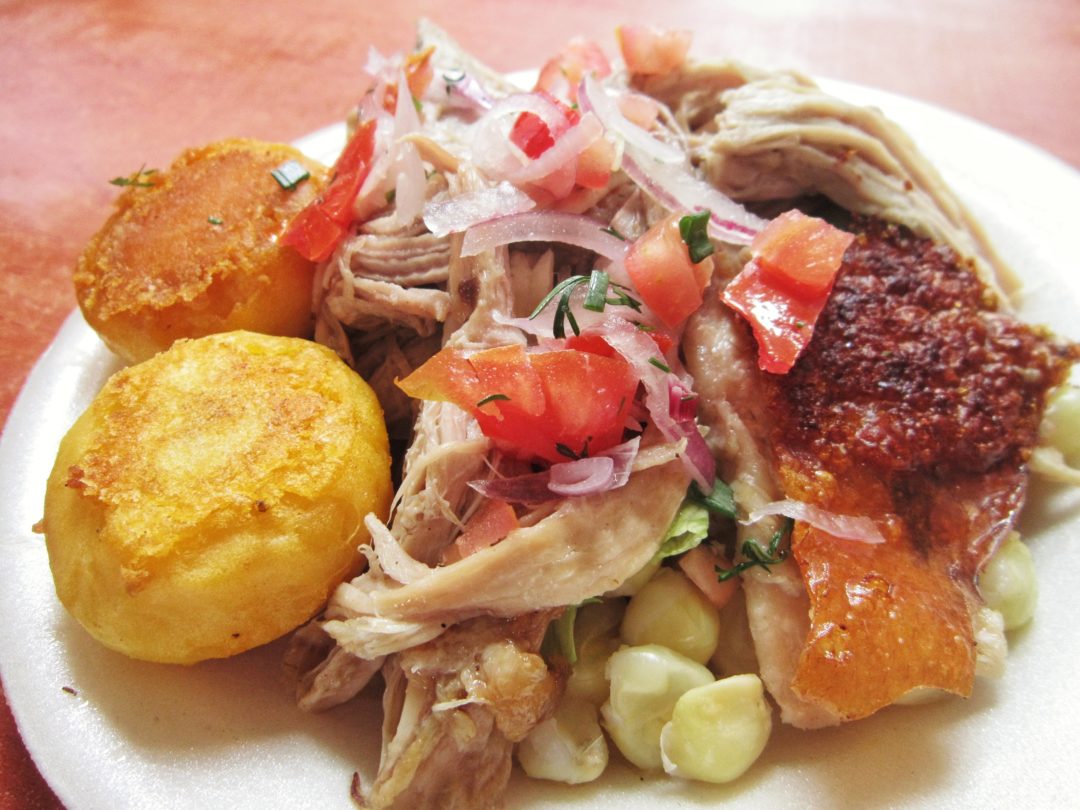
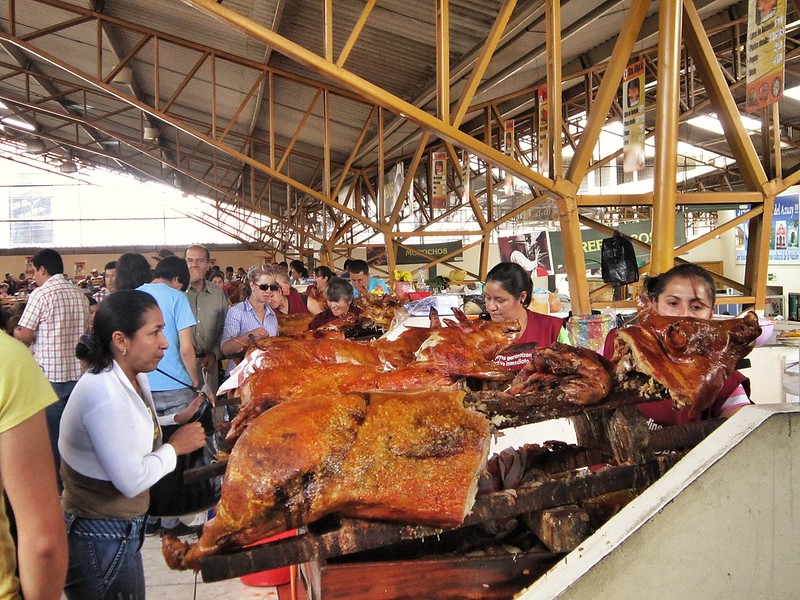
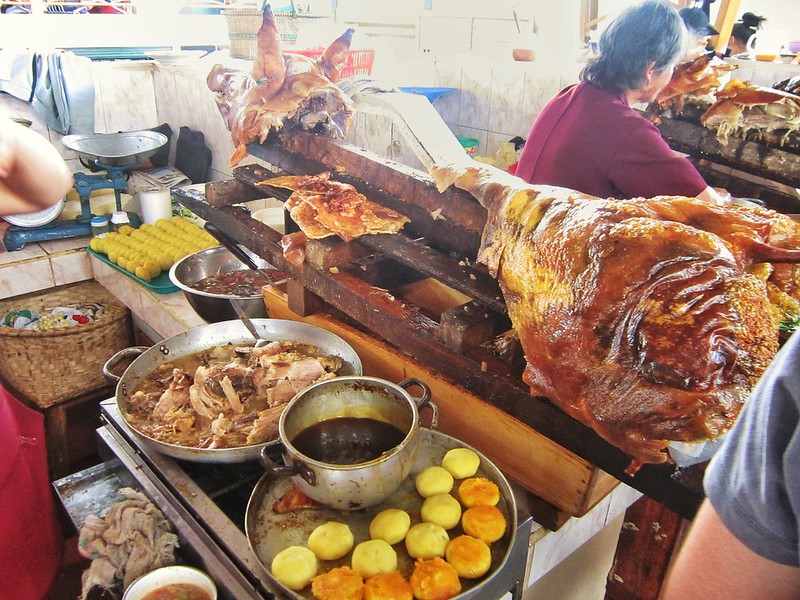
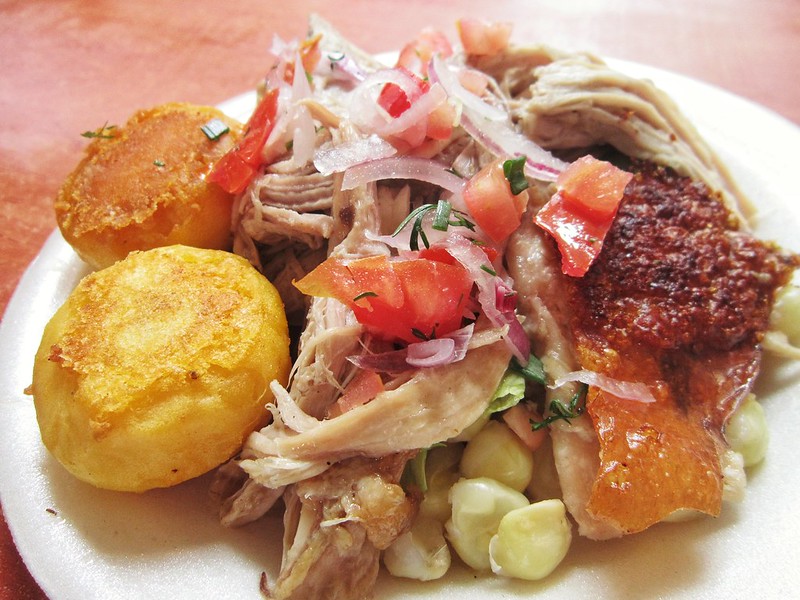
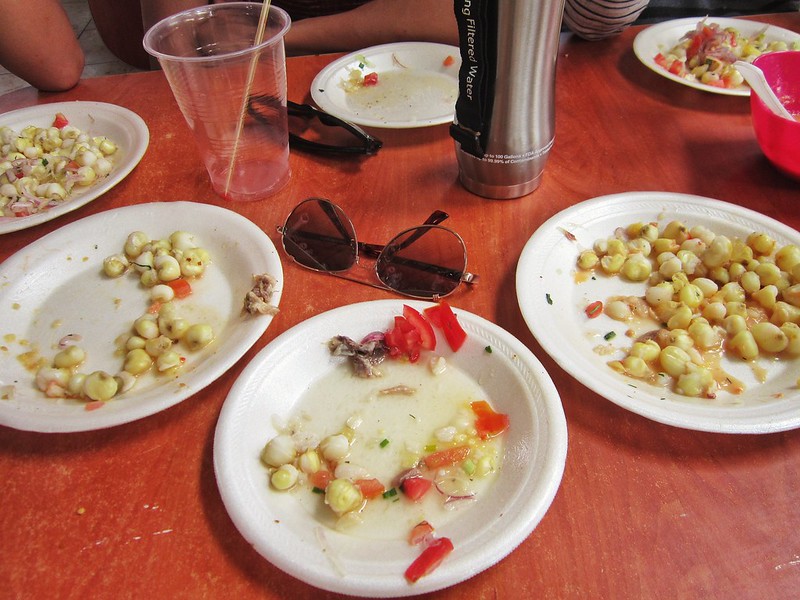

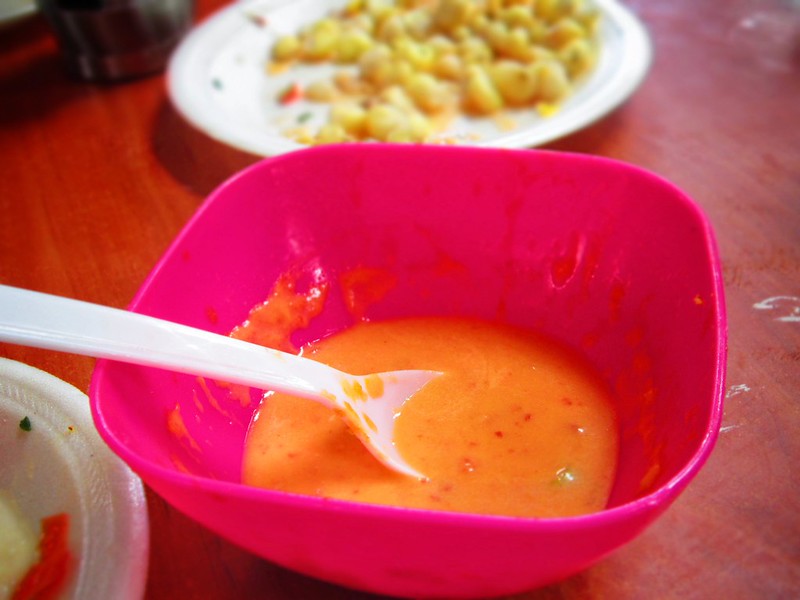




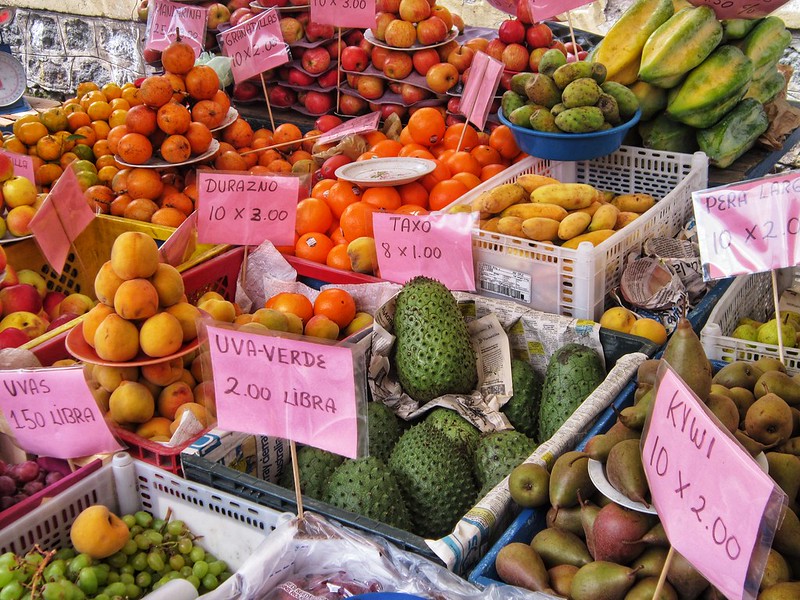
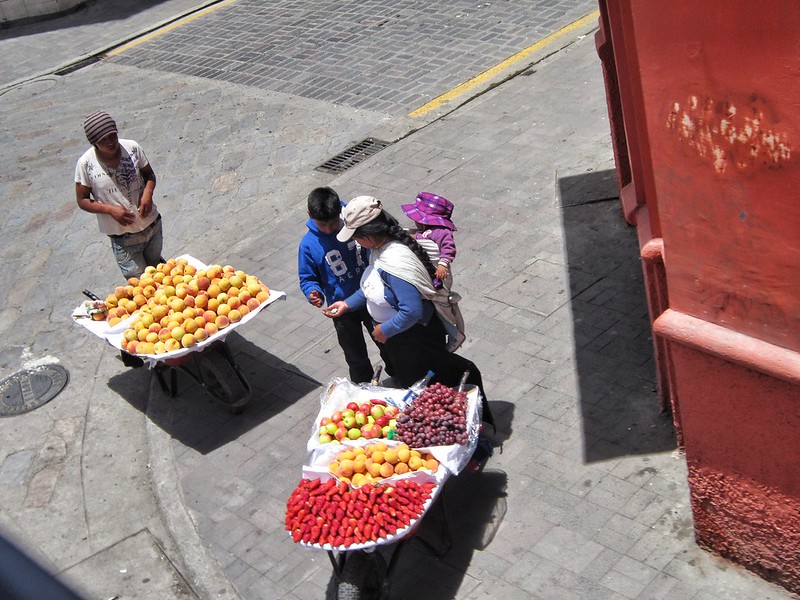


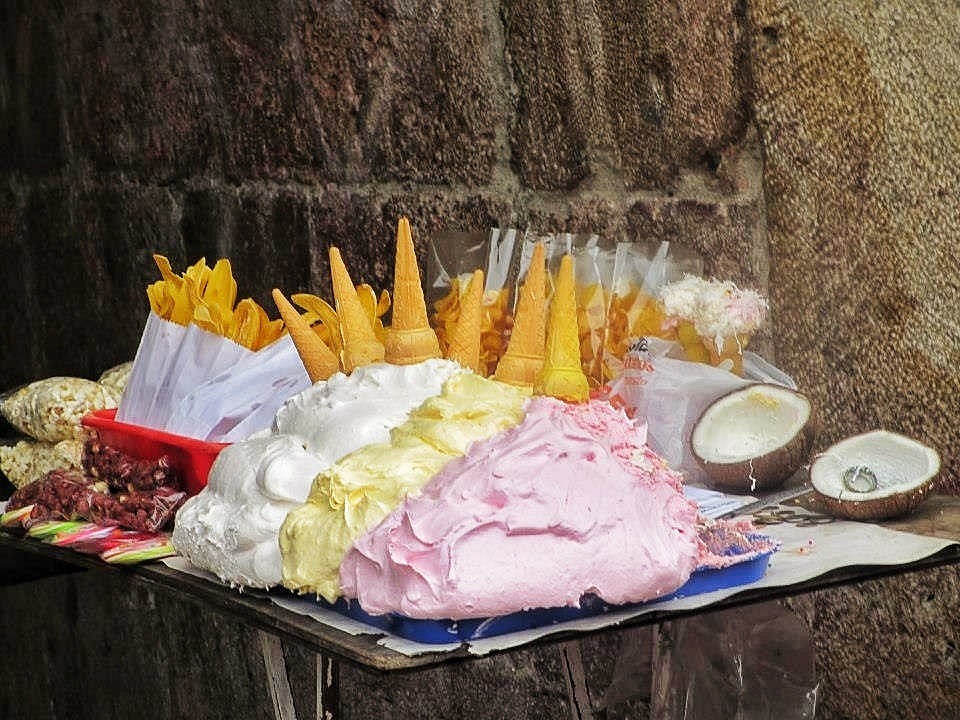
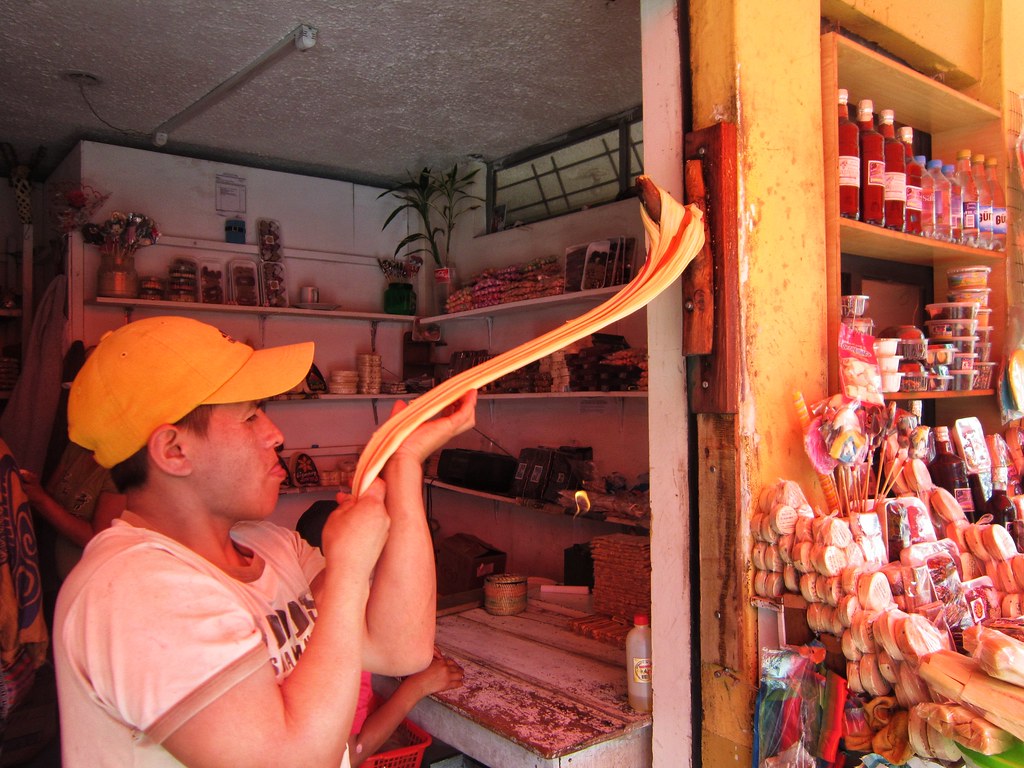


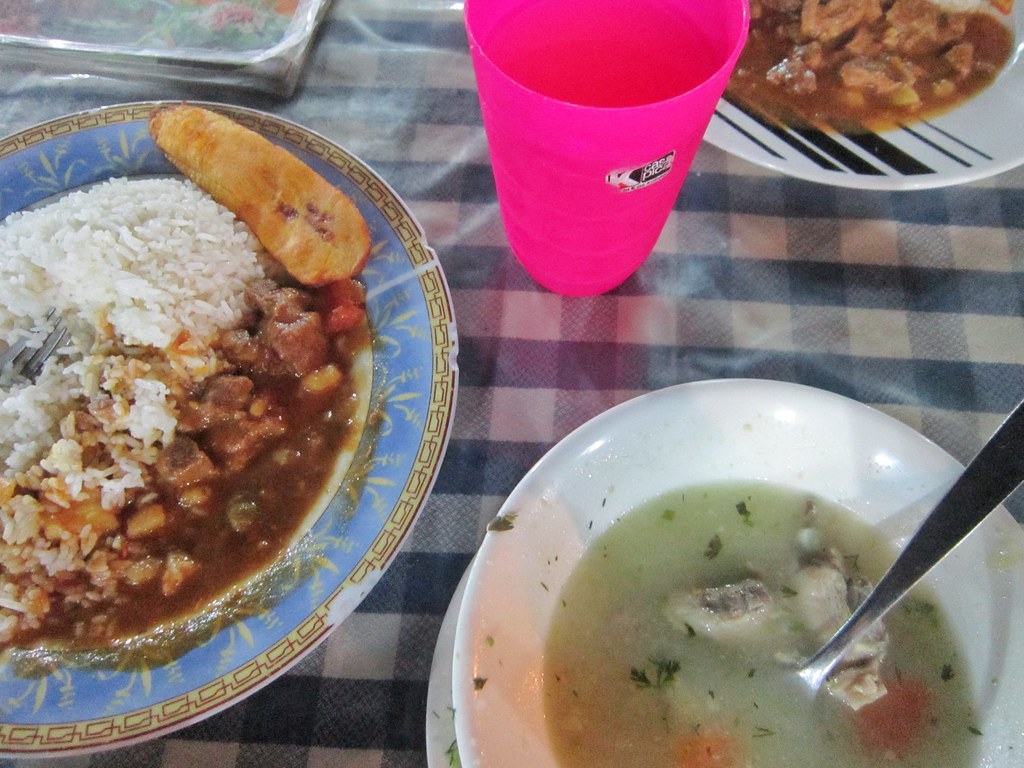
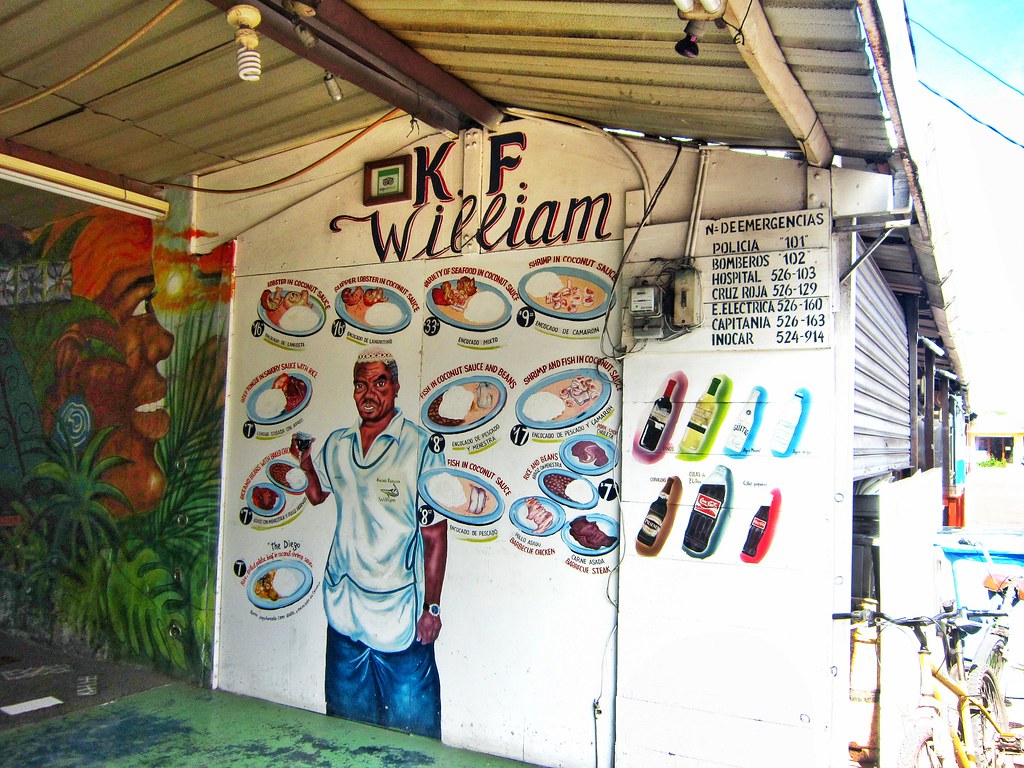
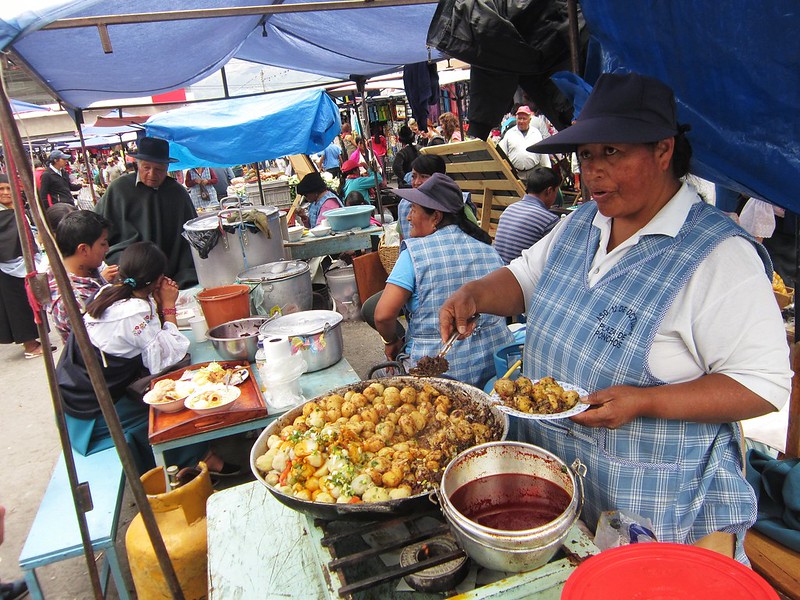
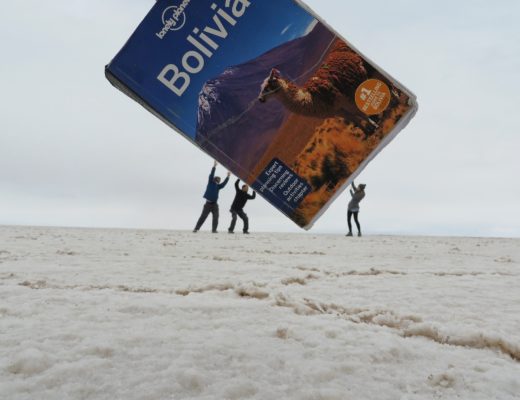

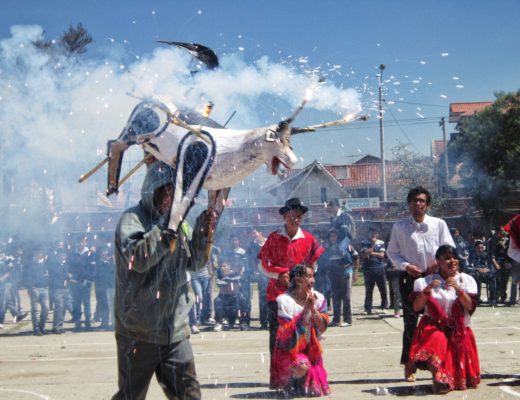
23 Comments
Thomas Dembie
May 11, 2013 at 4:18 amThe food looks delicious! I wish there were some good Ecuadorian restaurants where I live. Since there aren’t, I suppose I’ll have to make a trip of it one of these days 🙂
Flora
May 22, 2013 at 2:51 amA very good reason to come out to Ecuador 🙂
Julika
May 11, 2013 at 4:01 pmThis all looks so heavenly delicious! Although, as a vegetarian, I must admit that I find the facial expressions of animals on sticks slightly disturbing… but at least now I know I could live of ice cream and cookies if I ever ended up in Ecuador 🙂
Flora
May 22, 2013 at 2:52 amYep, the silent guinea pig screams are definitely not the most pleasant thing to look at.. Still haven’t chanced my luck with actually eating one yet. Thankfully I think there’s quite a few veggie-friendly things you could feast on if you make it out here!
mike
February 22, 2018 at 10:10 pmcuy as its called in Spanish.. youre not missing much. its not yummy,
Ashley of Ashley Abroad
May 12, 2013 at 2:13 pmGreat post! I went to Ecuador when I was 15 and didn’t appreciate the food as I know I would now- but I remember amazing coffee, lots of chicken foot soup, not wanting to eat guinea pig and having beans, rice and plaintains with everything. That pork looks amazing by the way, I wish I would’ve had some when I was there!
Flora
May 22, 2013 at 2:55 amAw that must have been a great trip though 🙂 I had the same issue when I went to Japan aged 8 – although I went mad for the sushi I definitely didn’t try as many foods as I could have. Lucky there’s always the option of heading out to those places again!
Steph
May 12, 2013 at 9:39 pmI love it! After two months in Colombia (which is amazing but SO BORING for food), Ecuador was like paradise! Mike was all over the Ceviche, particularly in Montanita and I loved the shrimp dishes and of course the pork. And all that corn.
The salty salad thing seems to be all over South America, I alway thought it was bizarre.
Flora
May 22, 2013 at 2:54 amAhh Steph, don’t tell me Colombian food is a downgrade from here! Are there not plentiful plates of pork at every turn?? Maybe I should eat pig every meal from now on to stock up…
Erin
May 24, 2013 at 2:00 pmI just wanted to share my blog with fellow like minded traveller. Hope you enjoy my hiliarious Ecuadorian adventure as much as I have enjoyed reading yours.
http://www.atruetalltale.wordpress.com
Inspiring Travel Lifestyle Blogs 1-15 May
May 26, 2013 at 3:17 pm[…] Eating All the Food in Ecuador – by Flora | Flora The Explorer […]
Samantha
June 1, 2013 at 11:47 pmI’ve had a few friends who studied abroad in Ecuador and they LOVED guinea pig! But no thanks for me, I’ll pass…I see them as furry friends still and the picture of the pigs on the spit reaffirms it 🙁
That ice cream looks amazingly delicious though! Planning on visiting Ecuador next year and can’t wait to try the pig and all the yummy desserts!
Flora
June 6, 2013 at 8:20 pmI’m still amazed I’ve managed to get through over four months in this country and still haven’t sampled the delights of cuy yet… The rest of Ecuador’s food, however, is lovely 🙂 SO MUCH PIG!!
Agness
June 8, 2013 at 11:53 amI’ve never been to Ecuador, but the food really looks so delicious. I’ve tried pig’s ears in China and had some bugs in Thailand so Educator meals would be that challenging to me :). Love to try one of those fruit shakes and meat bun 🙂
Flora
June 17, 2013 at 3:40 amAhh how did you find pig’s ears?! I actually quite enjoyed the Thai bugs but I found the prospect of sheep’s eyes in Iceland a little too difficult to attempt. Ecuador is much more tame in that respect I feel 🙂 The pig is almost too delicious for me to handle! Might have to grab some for lunch tomorrow now..!
Ceri
June 14, 2013 at 3:10 pmI did have trouble finding things to eat when I first got to Mexico because I’m a vegetarian (with a mostly vegan diet) but I definitely think being able to speak Spanish helps. 🙂 I know that Latin America in general is a very meat-heavy place, especially in the south, but I hope when I do get the chance to visit, I’ll be able to try all kinds of food too. 🙂
Abhishek (Wild Navigator)
August 27, 2013 at 10:07 amAmazing food – looks delicious & certainly would taste great. If I do travel to Ecuador, no to the pig ears for sure but would like to try the snakes & meat buns – that sounds different & worth the try 🙂 hope your doing well?
Abhishek (Wild Navigator)
August 27, 2013 at 10:09 amSorry for the auto correction on my phone – its not snakes but shakes 🙂 that’s mental my phone – a true wild navigator !!
Flora
September 6, 2013 at 12:24 pmHaha you’re such a wild navigator Abishek 🙂 I really miss Ecuadorian food actually, especially the plates of pig – the food throughout the continent really differs, I’m discovering!
Hey Tarija, Where's the Wine?!
December 12, 2013 at 2:27 am[…] again, but this time armed with the knowledge that she is our one barrier to delicious wine and a plate filled with pig. We place our food order with little issue, and then say we want a good wine to go with it. She […]
Brian
October 9, 2014 at 7:24 pmAmazing cuisine (sorry Guinea pigs). Thanks for the in-depth street food analysis!
Flora
October 18, 2014 at 11:12 amAhh, the guineas… sadly a necessary part of the Ecuadorian eating experience :p
Healthy Bizarre Foods Ecuador « Healthfood Tips
February 8, 2015 at 11:52 pm[…] Eating All the Food in Ecuador – Flora The Explorer – As is often the way when travelling, my daily lifestyle in Cuenca tends to revolve around food. More specifically, the time of day and my location in the city …… […]